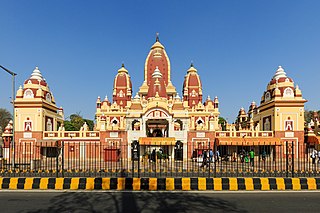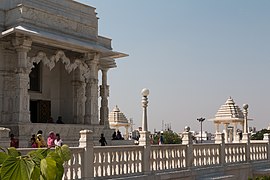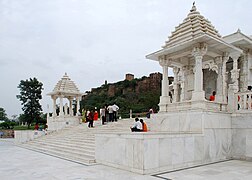
Jaipur is the capital and the largest city of the north-western Indian state of Rajasthan. As of 2011, the city has a population of 3.1 million, making it the tenth most populous city in the country. Located 268 km from the national capital New Delhi, Jaipur is also known as the Pink City due to the dominant color scheme of its buildings in old city.
The Birla family is a family connected with the industrial and social history of India.
Nawalgarh is a heritage city in Jhunjhunu district of Indian state of Rajasthan. It is part of the Shekhawati region and is midway between Jhunjhunu and Sikar. It is 31.5 km from Sikar and 39.2 km from Jhunjhunu. Nawalgarh is famous for its fresco and havelis and considered as Golden City of Rajasthan. It is also the motherland of some great business families of India.

Bhilwara is a city and administrative headquarters in Bhilwara district of the Mewar region of Rajasthan, India. It has been termed as 'Textile city'.

The Laxminarayan Mandir is a Hindu temple located in New Delhi, India. The presiding deity in the temple is Laxminarayan i.e., Vishnu along with his consort Lakshmi. The temple was inaugurated by Mahatma Gandhi. Gandhi ensured that members of all castes would be allowed in the temple. It was built by Jugal Kishore Birla from 1933 and 1939. There are also small shrines on the sides dedicated to Shiva, Ganesha, Hanuman and Buddha.

The Birla Mandirs refer to different Hindu temples or Mandirs built by the Birla family in different cities across India. All these temples are magnificently built, some in white marble or sandstone. The temples are generally located in a prominent location, carefully designed to accommodate a large number of visitors. The worship and discourses are well organized. The first one was built in 1939 in Delhi collectively by Jugal Kishore Birla and his brothers and their father. Later temples were built by and managed by different branches of the family. For both of the temples in Varanasi, the Birlas joined other donors to support the cost.

Makrana is an urban city located at the centre of Rajasthan in Kuchaman City District. It also served as a tehsil headquarters, with 136 villages under its jurisdiction thus making it the largest tehsil in the district. The biggest village of Makrana tehsil by area is Modicharna. Makrana is 110 km (68 mi) west of Jaipur and 190 km (120 mi) north-east of Jodhpur. Makrana is known for the part it has played in building the Taj Mahal by supplying marble, craftsmen and stonemasons to build the iconic UNESCO world heritage centre. It is one of the developing cities in the state. The marble from the town Makrana which is known as Makrana Marble, gets the GHSR status from the IUGS.

A Jain temple, Derasar or Basadi is the place of worship for Jains, the followers of Jainism. Jain architecture is essentially restricted to temples and monasteries, and Jain buildings generally reflect the prevailing style of the place and time they were built.

Galtaji is an ancient Hindu pilgrimage about 10 km away from Jaipur, in the Indian state of Rajasthan. The site consists of a series of temples built into a narrow crevice in the ring of hills that surrounds Jaipur. A natural spring emerges high on the hill and flows downward, filling a series of sacred kunds in which pilgrims bathe. Visitors and pilgrims can ascend the crevasse, continuing past the highest water pool to a hilltop temple from there are views of Jaipur and its fortifications spreads out across the valley floor. It is believed that a Saint named Galav lived here, practiced meditation, and did penance (tapasya).

Birla Mandir is a Hindu temple built on a 280 feet (85 m) high hillock called Naubath Pahad on a 13 acres (53,000 m2) plot in Hyderabad, Telangana, India. The construction took ten years and was opened in 1976 by Swami Ranganathananda of Ramakrishna Mission. The temple was constructed by the Birla Foundation, which has also constructed several similar temples across India, all known as Birla Mandir.

Rajasthan is one of the most popular tourist destinations in India, for both domestic and international tourists. Rajasthan attracts tourists for its historical forts, palaces, art and culture with its slogan "Padharo Mhare Desh " The capital city, Jaipur, also known as Pink City, is a very popular tourist destination and is a part of the Golden Triangle. The Walled City of Jaipur is only the second Indian city to be recognized as a UNESCO World Heritage Site, after Ahmedabad.
Sheth Jugal Kishore Birla was a scion of the Birla family and the eldest son of Baldeo Das Birla. He was a noted industrialist, philanthropist and vocal supporter of Hindu philosophy.

Malwas is a village and post in the Churu district of northern Rajasthan state, India.

Shri Vishwanath Mandir also known as Vishwanath Mandir, Vishwanath Temple, New Vishwanath Temple and Birla Temple is another prominent Hindu temple in the holy city of Varanasi. Hindus across India and abroad visit this particular Lord Shiva temple to offer prayer to the Lord Vishwanath for the well-being of their families, and eternal peace. Every Hindu must perform a specific ritualistic homage for the departed souls of their ancestors this requires them to undertake pilgrimage to the holy city of Varanasi. The temple is situated near the Banaras Hindu University. Therefore, the temple site and the neighbourhood is a major attraction among Hindu students and visitors touring Varanasi. Shri Vishwanath Mandir has the tallest temple tower in the world with the Shikhara's height being around 250 feet. The temple is colloquially called VT, an acronym of Vishwanath Temple. The temple is under direct administration of the BHU.
Hindu Temple and Cultural Center of the Rockies in Centennial, Colorado is the major Hindu Temple in the Denver, Colorado region. The Hindu Society of Colorado was incorporated in 1984. During 1996-2015 the temple was located in a former church building in Littleton. The formally designed temple opened on July 3, 2015. with Prana Pratishtha on June 5–7, 2015. The temple membership grew to include 1,500 families in 2011. The temple is non-regional and non-sectarian.
Laxmi Narayan Mandir or Lakshmi Narayan Temple may refer to the following Hindu temples dedicated to Lakshmi Narayan:

Moti Dungri is a Hindu temple complex dedicated to Lord Ganesha in Jaipur, Rajasthan. It was built in 1761 under supervision of Seth Jai Ram Paliwal. The temple is a popular tourist attraction in the city and is located next to the Birla Temple.

The BAPS Hindu Mandir Abu Dhabi in the UAE, is a traditional Hindu mandir built by the BAPS Swaminarayan Sanstha. Inspired by Pramukh Swami Maharaj (1921–2016) and consecrated by Mahant Swami Maharaj on 14 February 2024, this is the first traditional Hindu mandir in Abu Dhabi.

Kalki Mandir is a Hindu temple in Jaipur, Rajasthan, India, which was built by Jai Singh II in the 18th century. The temple is located in Sireh Deori Bazar opposite the palace gate. In the temple yard is a statue of a horse made of white marble. The temple contains statues of Kalki and Lakshmi.




















